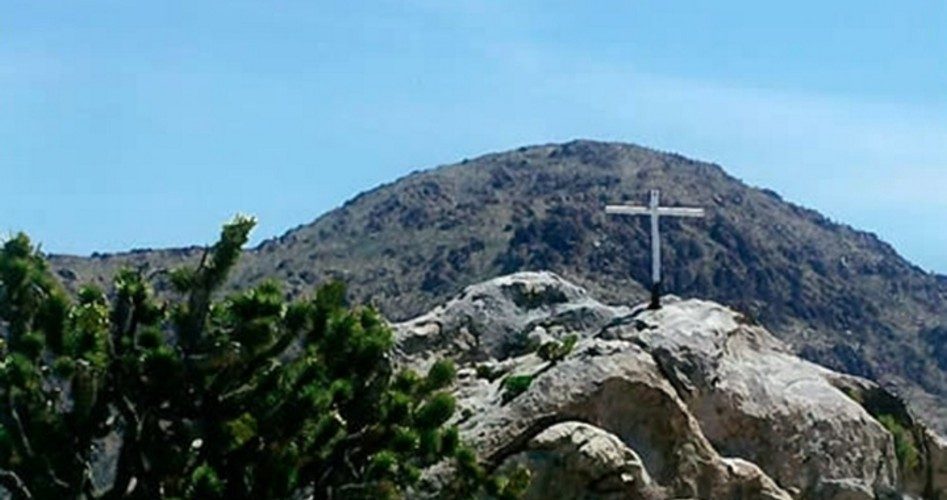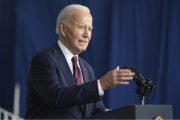
Nearly 80 years after a stark wooden cross was erected at Sunrise Rock in the Mojave National Preserve by veterans of World War I, and 13 years after it had been removed via an ACLU lawsuit, a seven-foot steel cross was returned to its place of honor in a solemn ceremony on November 11, Veterans Day, at Sunrise Rock.
First erected in the Mojave Desert in 1934 by Riley Bembry and other World War I vets, the cross and its site were maintained over the last several decades by Henry Sandoz, who lived in the area and promised Bembry that he would continue to care for the site after Bembry’s death. Over the years Sandoz replaced several crosses which had been stolen or destroyed, eventually erecting a more permanent cross constructed of steel pipes. But in 1994, the site became part of the Mojave National Preserve, and seven years later it was targeted by the ACLU, which sued to have the cross removed after a retired Park Service employee supposedly complained that its presence on public land was a violation of the First Amendment’s separation clause.
Ultimately a federal judge ruled for the ACLU, ordering the cross removed, and although Congress arranged for a land trade in 2003 to keep the cross in place, a federal judge blocked the plan from going through. In 2010 the U.S. Supreme Court ruled in favor of the land deal to keep the cross in its original location, ordering the lower court to re-visit the congressional transfer plan. In writing for the 5-4 majority, Justice Anthony Kennedy noted that the cross represents “thousands of small crosses in foreign fields marking the graves of Americans who fell in battles, battles whose tragedies are compounded if the fallen are forgotten.”
As reported in April by The New American, “shortly after the High Court’s decision, the metal cross — which had been indecorously encased in plywood to hide it, in compliance with the lower court order — was stolen from its place. But when it was replaced, the Park Service ordered the new cross to be removed.” That led to a suit filed by the Texas-based Liberty Institute on behalf of a number of veterans groups who have championed the cross display. “That suit pressed for the land swap to go forward,” reported The New American, “which U.S. District Judge Robert Timlin ordered April 20.”
“We now have a final order from the court,” said the Liberty Institute’s Kelly Shackleford at the time of the ruling, “and it’s just a matter of getting the land transferred. As soon as that happens, the veterans are going to put that memorial back up as it has been since 1934.”
That time came November 11, when the seven-foot steel-pipe replacement cross that the 73-year-old Sandoz had made and stored in a nearby barn, was solemnly raised as scores of veterans and their families looked on. “Riley would have never believed what has happened over these last years,” said Sandoz of his late friend who erected the original cross. “We want to thank our Lord and Savior most of all for watching over us and bringing us to this point to honor Him and the veterans. We are happy it has all come about, and we know that the Lord has been in this. We’ve seen His hand.”
Among the groups the Liberty Institute represented in the suit were the Veterans of Foreign Wars, the American Legion, and the Military Order of the Purple Heart. Hiram Sasser, director of litigation for the Liberty Institute, said that the observance marked the “the conclusion of the fight for the Mojave Veterans Memorial Cross. On the eleventh hour, of the eleventh day, of the eleventh month, the cross rose again like a phoenix under the desert sun as the VFW raised and rededicated the memorial once more. The veterans, through their own service and sacrifice for a good greater than themselves, earned this moment.”
The Mojave Desert Veterans Memorial is the only World War I memorial designated by Congress as a National Memorial. The Park Service has erected a fence around the site with entrances for visitors, and has posted signs noting that the memorial is on private land. A plaque at the cross states that it is a memorial for U.S. veterans.
Said Sasser of the efforts: “Judges and lawyers may have played their roles, but it was the veterans who earned this memorial, and it is for them it rises once more.”
Photo of WWI veteran’s monument at Sunrise Rock: AP Images



